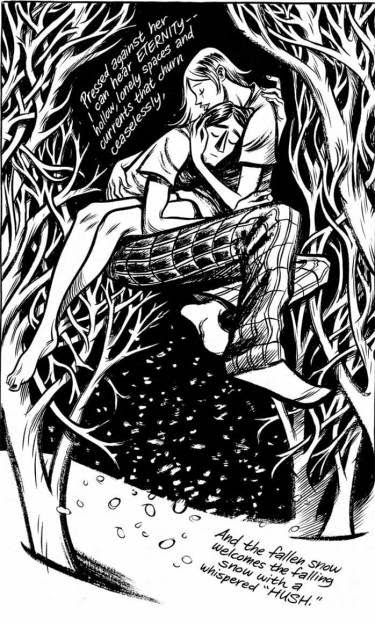‘Achingly beautiful’ is how Time magazine described
Blankets. It is a story about first love and self-awakening, tempered with
regret for a lost childhood.
Craig and his brother Phil, the children of fundamentalist
Christians, are growing up in a small town in Wisconsin. A skinny child, not
interested in sport or Heavy Metal, Craig is marginalised and bullied at
school, and an easy target for the teachers. As is common for those with
extreme beliefs, the home and church become a refuge from the evil, sinful
world, and they see themselves as the persecuted faithful.
The story revolves around the beautiful Raina, a mutual
misfit he meets at ‘Church Snow Camp’, and the first stumbling steps of their
romance, which blossoms as Craig stays with her during the holidays. Away from
his parents, the pull of fundamentalism is diminished, and his guilty
conscience is unable to put up much of a fight.
I have read the book three times now, and every time I also
fall in love with Raina. Beautiful, sensitive, intelligent, creative, generous
and fun. Is this nostalgia, for the perfect woman who does not exist, except as
a memory?
The beauty of Blankets is not just in the story, it is in
the artwork as well. Craig is an accomplished artist, and worked for DC, Marvel
and many other top publications. He uses brush and ink, working in black and
white. His work has a strong line, which is never merely a contour, but a
description of form and volume, light and shadow and expression and movement.
Craig communicates so much, sometimes without any words at
all. In one scene, Raina’s devoutly Christian father, looking into the spare
room one morning, seeing Craig’s bed neatly made, storms into Raina’s room and
finds them in bed together, clothes strewn over the floor. Then he looks at the
sleeping face of his daughter, seeing such contentment there, and maybe,
reflecting on his own failures, backs out of the room, quietly closing the door
behind him.
To what extent the hero of the book actually is one and the
same as the author is difficult to say. He is an innovative story teller, not
content to regurgitate mere facts. That said, it is so well observed that it
must be grounded in true events and real people.
In Blankets, the events of his childhood are seen through
the eyes of an angy, 24 year old man, and the book is cathartic, as he
exorcises his demons and satirises his tormentors. Yet he is not blinded by
anger – he has time for an affectionate portrayal of his parents, and he claims
that he retains a belief in the teachings of Christ, if not the teachings of
the church.
The things we angrily throw away one day, we later return to
for comfort, as we realise that the adversity we faced as a child has made us
the person we are today. I wonder if Craig would change one moment of his
childhood, which has shaped him into a strong individual, and a talented artist
and story teller.






No comments:
Post a Comment